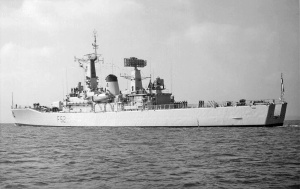HMS Juno (F52)

| |
| History | |
|---|---|
| Name | HMS Juno |
| Operator | Royal Navy |
| Builder | Vosper Thornycroft |
| Laid down | 16 July 1964 |
| Launched | 24 November 1965 |
| Commissioned | 18 July 1967 |
| Decommissioned | 4 November 1992 |
| Identification | Pennant number: F52 |
| Fate | Sold for scrap 1994 |
| General characteristics | |
| Class and type | Leander-class frigate |
| Armament | Twin 4.5 inch gun, 2x 20mm gun, 1x quadruple Seacat missile launcher, 1x3 barrel A/S mortar, 1x Wasp Helicopter |
HMS Juno was a Leander-class frigate of the Royal Navy (RN). Like the rest of the class, Juno was named after a figure of mythology. She was built by Thornycroft of Woolston, Hampshire. Juno was launched on 24 November 1965 and commissioned on 18 July 1967.
Operational Service
Juno had a variety of sunny deployments from commissioning in 1967 that culminated in a 1969 Far East Deployment, visiting a variety of ports in countries, including Singapore, Hong Kong, Japan, and South Africa, returning to the UK towards the end of 1971. Juno was one of a number of Leanders that undertook the Beira Patrol, in this case for five weeks while on her way back to the UK in 1971. The Beira Patrol was a deployment designed to stop oil reaching landlocked Rhodesia via the then Portuguese colony of Mozambique. Between 1969 and 1973, she was the senior ship (known as 'Captain D') of the fourth frigate squadron.
In the 1970s Juno was one of the six Leanders used as the fictional "HMS Hero" for the BBC TV drama series Warship. All members of the crew were given Hero cap tallies for filming purposes.
In 1976, Juno took part in the Third Cod War against Iceland during the fishing disputes with that country, and was, while on a Fishery Protection Patrol, rammed the Icelandic gunboat Tyr, quite notorious in its aggression towards RN vessels. The ramming caused a minor fire. Juno made a second patrol, and was again confronted by the gunboat Tyr which was rammed by Juno yet again.
Following the damage received whilst undertaking fishery protection duties, Juno underwent a substantial refit in 1977, and following intensive workup at Portland in March 1978, joined the 5th Frigate Squadron for a nine month deployment. Ports visited during this time were: Brest, Bermuda, Belize, Tortolla, Panama, San Diego, Victoria, Prince Rupert, San Francisco, Acapulco, Panama, Puerto Rico, Dominica, Key West.
During the visit to Dominica in November 1978, Juno was the warship present when Princess Margaret formally handed over independence. For the ceremony at the cricket pavilion, Juno provided the ceremonial guard and colour party.
In 1980, Juno joined the Standing Naval Force Atlantic (STANAVFORLANT), a NATO multi-national squadron, a role Juno was familiar with, having often deployed with NATO multi-national squadrons. The following year, Juno, due to the 1981 Defence Review by the defence minister John Nott, was placed in reserve when she joined the standby squadron. In 1985, Juno completed a four-year refit, which removed all her weapons and converted her into a navigational training ship. The following year Juno, ironically as the navigational training ship, grounded in the Solent, which forced her to receive repairs. In 1987, Juno's bit of bad luck continued when she collided with the Type 21 frigate Active.
Fate
Juno decommissioned in November 1992. She was sold for scrap in 1994.
Commanding Officers

HMS Juno in 1968
| From | To | Captain |
|---|---|---|
| 1967 | 1969 | Captain R D Lygo RN |
| 1969 | 1971 | Captain K Vause RN |
| 1975 | 1977 | Captain Edward R Anson RN |
| 1978 | 1979 | Commander M Bickley RN |
References
Publications
- Colledge, J. J.; Warlow, Ben (2006) [1969]. Ships of the Royal Navy: The Complete Record of all Fighting Ships of the Royal Navy (Rev. ed.). London: Chatham Publishing. ISBN 978-1-86176-281-8.
- Marriott, Leo, 1983. Royal Navy Frigates 1945-1983, Ian Allen Ltd. ISBN 07110 1322 5
